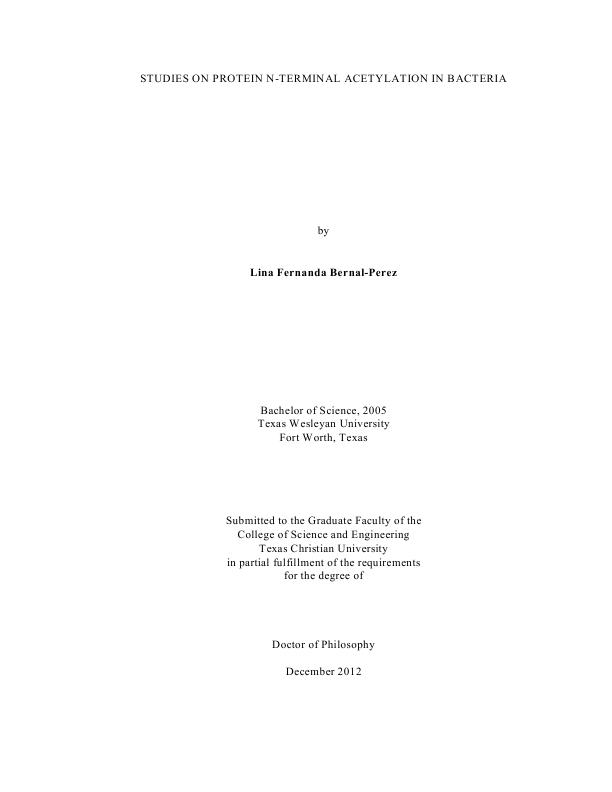Studies on protein N-terminal acetylation in bacteriaShow full item record
| Title | Studies on protein N-terminal acetylation in bacteria |
|---|---|
| Author | Bernal-Perez, Lina Fernanda |
| Date | 2012 |
| Genre | Dissertation |
| Degree | Doctor of Philosophy |
| Abstract | N-terminal (Na) protein acetylation, one of the most common post-translational modifications in eukaryotes, plays a pivotal role in the stability, activity and targeting of certain proteins (Chapter 1). This protein modification is significantly less frequent in prokaryotes. In Escherichia coli, the only Na-acetyltransferases identified are RimI, RimJ, and RimL, which acetylate the ribosomal proteins S18, S5 and L7/L12, respectively. Although most eukaryotic proteins are not acetylated when ectopically expressed in E. coli, partial or complete Na-acetylation has been reported for several recombinant proteins. Just recently, it was demonstrated that Na-acetylation of the thymosin a1 fusion proteins is catalyzed by RimJ. For most other proteins, however, the underlying mechanism of Na-acetylation remains unknown. We recently observed that the Z-domain protein, a small three-helix bundle protein derived from the Staphylococcal protein A, is Na-acetylated only under certain conditions. We decided to use the Z-domain as a model protein to study the Na-acetylation in E. coli. We revealed that the Na-acetylation of the Z-domain depends on the E. coli strains, expression vectors and amino acid residues near the N-terminus, and is enhanced by high cellular levels of RimJ (Chapter 2). In order to systematically study the sequence dependence of the N-terminal methionine cleavage and RimJ-mediated Na-acetylation in E. coli, the Z-domain variants differing by the second or third amino acid residue were expressed and analyzed by mass spectrometry (Chapter 3). The initiating methionine residue of the Z-domain was removed only when a small and uncharged amino acid residue was in the second position. Only subsequent to the cleavage of the initiating methionine residue, the RimJ-catalyzed N-terminal acetylation mainly occurred at the N-terminal serine and threonine residues and was significantly enhanced by a hydrophobic or negatively charged residue in the penultimate position. Although primarily used for analysis of N-terminal acetylation, mass spectrometry often requires careful sample preparation and expensive instrumentation. Therefore, in order to find a simple and sensitive method to analyze the acetylation status of proteins, we developed a fluorogenic derivatization method using 4-chloro-7-nitrobenzofurazan (NBD-Cl) (Chapter 4). The unacetylated protein selectively reacted with NBD-Cl at neutral pH to provide high fluorescence. In contrast, the Na-acetylated protein was essentially non-fluorescent under the same conditions despite the presence of many internal lysine residues. This method should be particularly useful for a large scale high-throughput proteomic analysis of protein Na-acetylation. |
| Link | https://repository.tcu.edu/handle/116099117/4373 |
| Department | Chemistry and Biochemistry |
| Advisor | Ryu, Youngha |
Files in this item
This item appears in the following Collection(s)
- Doctoral Dissertations [1514]
© TCU Library 2015 | Contact Special Collections |
HTML Sitemap



